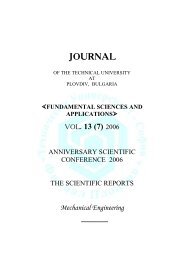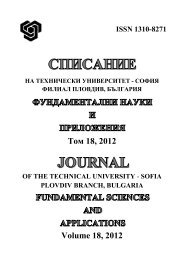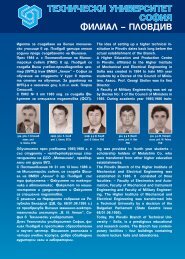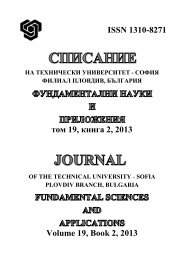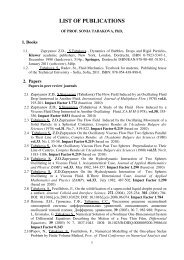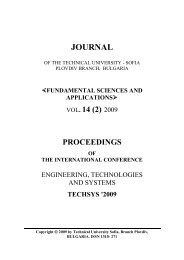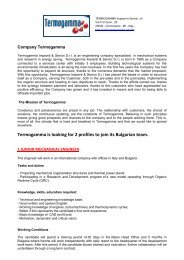44 At. Georgieva, St. Kostadinov2 Statement of the problemLet X be an arbitrary real Banach space with norm |.| <strong>and</strong> identity operator I. Weconsider the impulse differential equationdxdt = f(t, x), (t ≠ t n) (1)x(t + n ) = Q n (x(t n )), (2)where f : [a, b] × X → X is a continuous function, the operatorsQ n : X → X (n = 1, 2, ...p) are continuous <strong>and</strong> a < t 1 < t 2 < ... < t p ≤ b. Weassume that all functions are left continuity at t n .Let X ∗ be the dual space of X <strong>and</strong>F x = {x ∗ ∈ X ∗ : x ∗ (x) = |x| 2 = |x ∗ | 2 }(x ∈ X).Using F we introduce the semi-scalar product [6], [8](x, y) − = inf{y ∗ (x) : y ∗ ∈ F y}. (3)In [6] many well-known properties of the semi-scalar product are shown. Here,we remark only that if X is a Hilbert space, then the semi-scalar product in (3) isequal to the ordinary scalar product.Remark 1. If X is a complex Banach space, we can introduce a semi-scalar productby the formula(x, y) − = Re(x, y) − + iIm(x, y) − ,whereRe(x, y) − = inf{Re y ∗ (x) : y ∗ (y) ∈ R <strong>and</strong> y ∗ (y) = |y| 2 },Im(x, y) − = inf{Im y ∗ (x) : y ∗ (y) ∈ R <strong>and</strong> y ∗ (y) = |y| 2 }.It is easy to show that Lemma 3.2 [6] is valid in the complex case too.We setc = sup |f(t, 0)|.a≤t≤bDefinition 1. [6] We say that X is a strictly convex space if x ≠ y <strong>and</strong>|x| = |y| = 1 imply |λx + (1 − λ)y| < 1 for λ ∈ (0, 1).Let ω : (a, b] × R + → R be an arbitrary function.We introduce the conditions.H1. The inequality ω(t, 0) ≥ 0 (a < t ≤ b) holds.
Existence of Bounded <strong>and</strong> Periodic Solutions of Nonlinear Impulse ... 45H2. The inequalityx ′ (t) ≤ ω(t, x) + x 2 + c22xhas for any p > a on [p, b] only bounded solutions, where z ′ = D(z) denotes the leftupper derivate of the function z at the point t ([5], [6]).H3. (dissipative condition) [6](f(t, x) − f(t, y), x − y) −≤ ω(t, |x − y|)|x − y|(t ∈ (a, b]; x, y ∈ X).Remark 2. It may be noted that the functions ω(t, x) = κxω(t, x) = x , t ∈ (a, b]. satisfy the conditions H1 <strong>and</strong> H2.t(κ-constant) orThe aim of the present paper is the search for sufficient conditions for the existenceof bounded <strong>and</strong> periodic solutions of the impulse equation (1), (2) if theconditions H1 − H3 are fulfilled.3 Main resultsTheorem 1. Let the conditions H1 − H3 be fulfilled. Then the impulse equation(1), (2), x(a) = ξ has for any ξ ∈ X an unique solution ϕ bounded on [a, b], forwhich ϕ(a) = ξ.Proof. It is sufficient to show the assertion for an ordinary equation, i.e. Q n =I (n = 1, 2, ...p).For any k ∈ N there exists a function x k (t) such thatDx k (t) = f(t, x k (t)) + ε k (t), |ε k (t)| ≤ 1 k(a ≤ t ≤ b).For arbitrary m, n ∈ N we setϕ m,n (t) = |x m (t) − x n (t)| 2 , ψ m,n (t) =Now from Lemma 3.2 [6], we obtain√ϕ m,n (t), |ε k | = 1 k .ψ ′ m,nψ m,n ≤ (x ′ m − x ′ n, x m − x n ) −= (f(t, x m ) − ε m − f(t, x n ) + ε n , x m − x n ) −≤≤ (f(t, x m ) − f(t, x n ), x m − x n ) −+ (ε m − ε n , x m − x n ) −≤≤ ω(t, √ ϕ m,n ) √ ϕ m,n + |ε n − ε m | √ ϕ m,n<strong>and</strong>ϕ ′ m,n ≤ 2ω(t, √ ϕ m,n ) √ ϕ m,n + 2( 1 m + 1 n )√ ϕ m,n . (4)
- Page 1 and 2: JOURNALOF THE TECHNICAL UNIVERSITYA
- Page 3 and 4: 3СПИСАНИЕHA TEXH»◊EC »f
- Page 5 and 6: 5CONTENTSPage1. A Connection on Man
- Page 7 and 8: c○Journal of Technical University
- Page 9 and 10: A Connection on Manifolds with a Ni
- Page 11 and 12: A Connection on Manifolds with a Ni
- Page 13 and 14: A Connection on Manifolds with a Ni
- Page 15 and 16: A Connection on Manifolds with a Ni
- Page 17 and 18: A Connection on Manifolds with a Ni
- Page 19 and 20: A Connection on Manifolds with a Ni
- Page 21 and 22: c○Journal of Technical University
- Page 23 and 24: Some properties of one connection o
- Page 25 and 26: Some properties of one connection o
- Page 27: Some properties of one connection o
- Page 30 and 31: 30 Albena Kosseva, Stepan Kostadino
- Page 32 and 33: 32 Albena Kosseva, Stepan Kostadino
- Page 34 and 35: 34 Albena Kosseva, Stepan Kostadino
- Page 36 and 37: 36 Albena Kosseva, Stepan Kostadino
- Page 38 and 39: 38 Albena Kosseva, Stepan Kostadino
- Page 40 and 41: 40 Albena Kosseva, Stepan Kostadino
- Page 42 and 43: 42 Albena Kosseva, Stepan Kostadino
- Page 46 and 47: 46 At. Georgieva, St. KostadinovFro
- Page 48 and 49: 48 At. Georgieva, St. KostadinovThe
- Page 50 and 51: 50 At. Georgieva, St. KostadinovPro
- Page 52 and 53: 52 At. Georgieva, St. Kostadinovi.e
- Page 54 and 55: 54 At. Georgieva, St. Kostadinov[5]
- Page 56 and 57: 56 At. Georgieva, St. Kostadinov2 S
- Page 58 and 59: 58 At. Georgieva, St. KostadinovRem
- Page 60 and 61: 60 At. Georgieva, St. Kostadinov3.2
- Page 62 and 63: 62 At. Georgieva, St. KostadinovIn
- Page 64 and 65: 64 At. Georgieva, St. Kostadinovtha
- Page 66 and 67: 66 At. Georgieva, St. Kostadinov
- Page 68 and 69: 68 Peyo Stoilov‖f‖ H ∞ = supz
- Page 70 and 71: 70 Peyo Stoilov(∫≤T|f(ζ)| q(
- Page 72 and 73: 72 Peyo StoilovRemark. We note that
- Page 74 and 75: 74 Peyo StoilovRemark. Theorem 3 wa
- Page 76 and 77: 76 Peyo Stoilov





